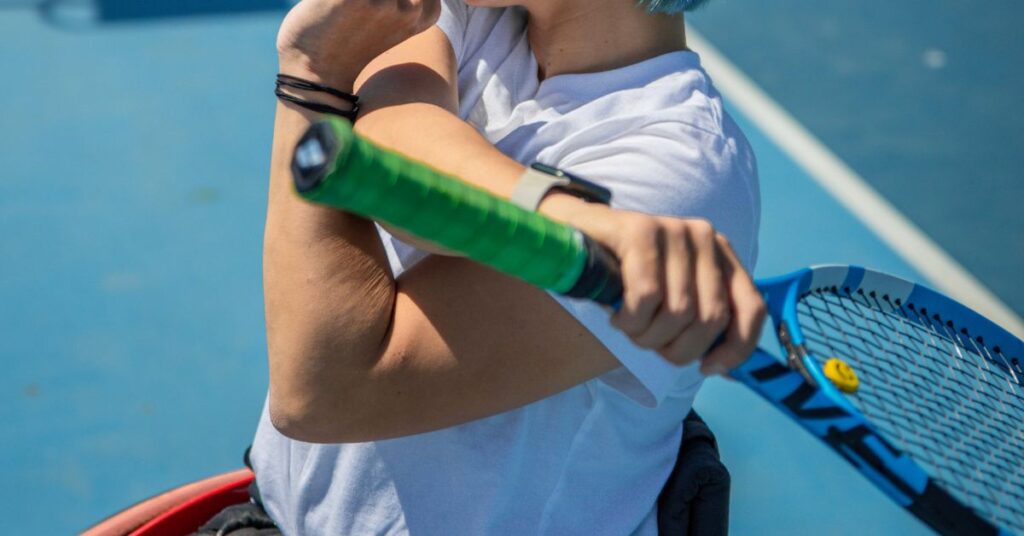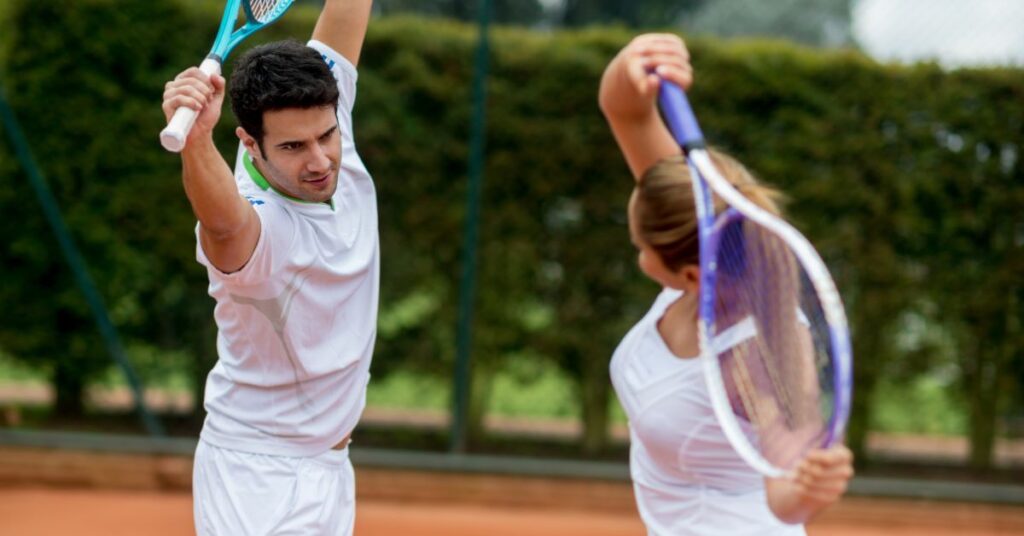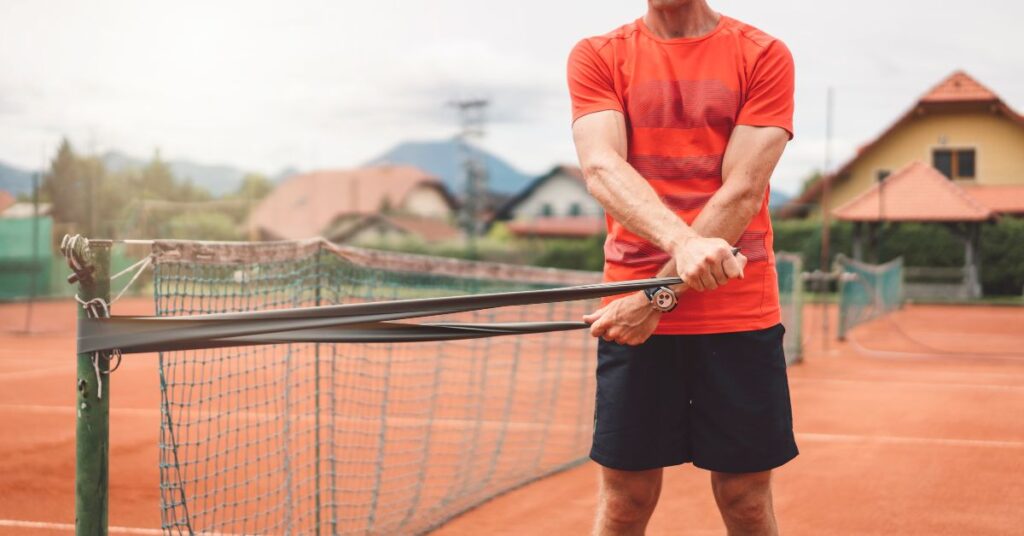If you’re anything like me, you’ve felt that post-tennis stiffness that hits the next day—tight hamstrings, sore shoulders, maybe even an achy lower back. After years of playing tennis recreationally and occasionally competitively, I’ve come to realize that tennis recovery stretches aren’t just a nice bonus—they’re essential.
Without them, I’m slower, less agile, and more prone to injury. If you’re reading this, chances are you’ve been there too. So let’s talk about why tennis recovery stretches are so important and exactly how you can use them to recover faster and play better.
Table of Contents for Tennis Recovery Stretches
Why Tennis Recovery Stretches Matter
Tennis is a high-impact, high-intensity sport. You’re twisting, sprinting, lunging, and serving—often all in one point. It’s no wonder that without proper recovery, your body can feel like it’s taken a beating. I used to think a quick quad stretch after the match was enough, but I’ve since learned that a full recovery routine with dedicated tennis recovery stretches makes a world of difference.
When you don’t stretch after tennis, your muscles stay tight, lactic acid builds up, and your risk of injury increases. Stretching helps flush out waste products, improves flexibility, and promotes better blood flow to sore muscles. I’ve personally noticed less soreness and faster bounce-back time when I’m consistent with my recovery routine.
One of the most powerful reasons for adding tennis recovery stretches is that they improve your range of motion, allowing you to move more freely, change direction with ease, and return tough shots more effectively.
The Best Tennis Recovery Stretches for Full-Body Relief
Let’s dive into some of the most effective tennis recovery stretches that you can add to your post-match routine. These stretches target the areas most affected by tennis—your shoulders, back, hips, legs, and wrists.
1. Standing Forward Fold (Hamstrings and Lower Back)
After a long match, my hamstrings feel like guitar strings—tight and on the verge of snapping. The standing forward fold is a gentle way to release tension from the lower back and stretch the entire back of your legs.
How to perform:
Stand with your feet hip-width apart. Hinge at the hips and slowly fold forward, letting your arms hang down or grabbing opposite elbows. Keep a slight bend in the knees if needed. Hold for 30 seconds and breathe deeply.
I do this stretch immediately after taking off my tennis shoes—it’s grounding and helps me transition into recovery mode.
2. Hip Flexor Stretch (Lunge Stretch)
When you’re constantly changing direction on the court, your hip flexors take a beating. This stretch helps open up the front of the hips and can even ease lower back discomfort.
How to do it:
Step one foot forward into a lunge position, with your back knee resting on the ground. Push your hips forward gently until you feel a stretch in the front of your hip. Hold for 30 seconds, then switch sides.
I like to combine this stretch with deep breathing—it helps me wind down mentally too.
3. Figure Four Stretch (Glutes and Hips)
This is one of the tennis recovery stretches I never skip, especially after a long hitting session. It targets the glutes and piriformis, which can tighten up quickly after all those lunges and explosive movements.
How to do it:
Lie on your back with both knees bent. Cross your right ankle over your left thigh. Reach through and grab the back of your left thigh, gently pulling it toward your chest. Hold for 30 seconds, then switch legs.
You’ll be amazed at how much tension this stretch releases—sometimes I feel instant relief.
4. Child’s Pose (Lower Back and Shoulders)
This yoga pose is an excellent full-body recovery stretch. It decompresses the spine and stretches the shoulders and hips—perfect for when your whole body feels tight.
How to do it:
Kneel on the floor, sit back on your heels, and fold your torso forward, stretching your arms in front of you. Rest your forehead on the mat and breathe deeply.
This stretch is one of my go-to’s after a long match. It helps me reset and reflect on the game.
5. Thread the Needle (Shoulders and Upper Back)
Your shoulders do a lot of work in tennis, especially with serving and overhead shots. This stretch relieves shoulder tension and increases upper back mobility.
How to do it:
Start on all fours. Slide your right arm underneath your left arm, allowing your right shoulder and temple to rest on the mat. Hold for 30 seconds and switch sides.
Add this to your tennis recovery stretches routine and you’ll notice less shoulder tightness, especially if you’re a serve-heavy player like me.
Read this: 10 Best Shoulder Exercises for Tennis: Protect Your Game
6. Seated Spinal Twist (Spine and Obliques)
Tennis involves a lot of torso rotation, and this stretch helps to reset your spine and relieve pressure in the lower back.
How to do it:
Sit on the floor with both legs extended. Bend your right knee and cross it over your left leg, placing your right foot flat on the ground. Twist to the right, placing your right hand behind you and your left elbow outside your right knee. Hold, then switch sides.
This one always reminds me how much tennis affects my core muscles—it’s a subtle but powerful stretch.
7. Wrist Flexor Stretch
Whether you’re hitting forehands or volleys, your wrists work hard during a tennis match. This stretch is simple but incredibly effective.
How to do it:
Extend your right arm straight in front of you, palm facing up. Use your left hand to gently pull your fingers back toward your body. Hold for 15-30 seconds, then switch hands.
Incorporating wrist stretches into your tennis recovery stretches will help you avoid overuse injuries like tennis elbow.
8. Calf Stretch (Wall or Step)
Your calves are constantly working when you sprint for drop shots or chase lobs. Stretching them helps with mobility and reduces the risk of cramping.
How to do it:
Place your hands on a wall and step one foot back, pressing the heel into the floor. Keep your back leg straight and front knee bent. Hold for 30 seconds per side.
When I don’t do this, I notice more soreness the next morning—calves are sneaky like that.
9. Neck Stretch (Side Tilt)
Believe it or not, your neck can get tight from tracking balls and turning your head repeatedly. This gentle stretch eases tension in the neck and traps.
How to do it:
Sit or stand tall. Gently tilt your head to one side, bringing your ear toward your shoulder. Use your hand to apply light pressure for a deeper stretch. Hold, then switch sides.
It’s a quick one to do while you sip water and reflect on the match.
10. Butterfly Stretch (Inner Thighs)
This is another favorite of mine and one of the most underrated tennis recovery stretches. It targets the adductors, which often get tight during lateral movement.
How to do it:
Sit on the floor with your feet together and knees bent outward. Hold your feet with your hands and gently press your knees toward the floor. Hold for 30 seconds.
I like doing this stretch while chatting with my hitting partner post-match—it’s social and practical.
From the Club to the Fame Hall Of…
It doesn’t matter if you’re a weekend warrior or dreaming of the tennis legends—taking care of your body through recovery is what will keep you on the court. These tennis recovery stretches aren’t just for pros—they’re for every one of us who loves the game and wants to keep playing it longer and stronger.
More about Tennis Recovery Stretches
Should You Stretch After Playing Tennis?
Absolutely—yes, yes, a thousand times yes! I used to skip stretching because I was either too tired or just eager to get on with my day. Big mistake. Without stretching, my muscles felt stiff and heavy the next morning, and I’d dread walking up stairs (don’t even get me started on lunges).
Stretching after playing helps you cool down, release tension, and recover faster. It’s like giving your body a little “thank you” for the hard work it just did. Even 10 minutes makes a huge difference—I promise your future self will be grateful.
How to Stretch Back After Tennis?
Oh, the back! It takes a serious beating after all those serves, overheads, and constant twisting. My go-to back stretches after tennis are child’s pose, thread-the-needle, and a gentle spinal twist while lying down or seated. I lie on my mat, breathe deeply, and let gravity do the work.
Sometimes, I’ll even roll gently side to side to massage the muscles around my spine. If you’ve ever walked off the court with your back feeling like it aged 10 years in two sets, these stretches are your best friends.
How Do You Recover From a Tennis Match Fast?
Fast recovery? Sign me up. For me, it’s all about the combo: hydrate like crazy, eat something with protein and carbs (a smoothie or banana with peanut butter is my go-to), and then dive into a solid stretching routine. I also swear by foam rolling my legs, especially the quads and calves.
If it was a really intense match, I’ll even treat myself to a warm Epsom salt bath—it’s like a spa day for sore muscles. Oh, and sleep! A good night’s rest might be the most underrated recovery tool out there.
What Are the Best Stretches for Tennis?
I’ve tested quite a few, and these are the ones I never skip: forward fold (for the hamstrings), hip flexor lunge (for those tight hips), figure four (glutes!), and thread-the-needle (shoulders and upper back).
Add in a butterfly stretch for your inner thighs and child’s pose for the lower back and you’ve got a full-body recovery lineup. These aren’t just the best tennis stretches—they’re the ones that keep me feeling loose, limber, and ready for the next match.
How’s your warm up guys?
Wrapping Up: Don’t Skip Tennis Stretches After Match Play
If you’ve been overlooking post-match recovery, let this be your wake-up call. Tennis recovery stretches aren’t just for professional players—they’re for anyone who wants to stay on the court longer, feel better, and play their best. I’ve learned the hard way that skipping this step leads to more pain and fewer good days on the court. You don’t need to stretch for hours—just enough to show your body some love.
So next time you finish a match, take a few extra minutes. Roll out your mat. Breathe deeply. And move through these tennis recovery stretches. Trust me, your future self—and your next serve—will thank you.
They’re not only the best tennis stretches I’ve found—they’re your key to consistent performance and recovery.
Pin this!
Related Reading for Tennis Recovery Stretches
- 10 Best Tennis Racket Bags on the Market Today
- 10 Ultimate Tennis Warm Up Exercises for Tennis Players
- How to Hold a Tennis Racquet: Best 4 Grips
- How to Serve in Tennis: Master the Perfect Technique in 6 Steps
- How Tennis Scoring Works: Best Guide to Get the First 15!
- How to Do a Backhand Tennis: 4 Key Steps to Master the Shot
- How to Choose Tennis Shoes – 4 Best Tips for Your Playing Style









